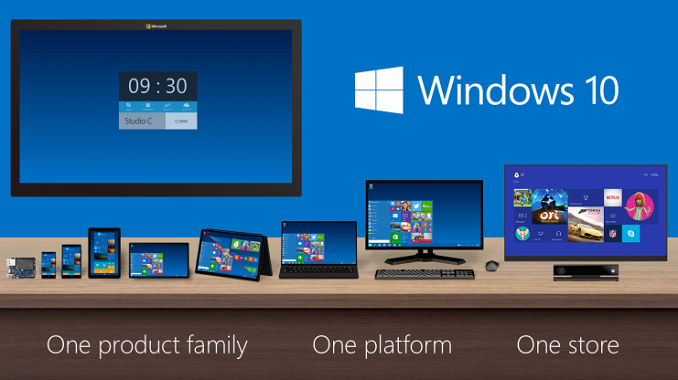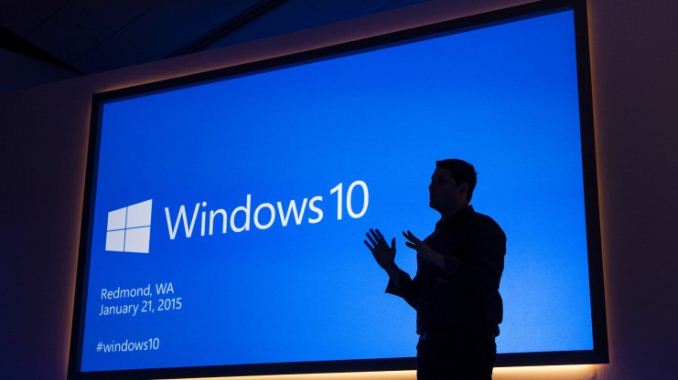Microsoft Announces Free Windows 10 Update
by Brett Howse on January 21, 2015 5:22 PM EST- Posted in
- Operating Systems
- Windows
- Microsoft
- Windows 10

Today Microsoft took the wraps off of their updates to Windows 10, and announced many of the consumer facing features that will be coming with the next version. Likely the biggest announcement of the day came right at the start of the keynote, with a drastic change in the Windows licensing model. There is a lot to discuss, and the keynote itself was over two hours long, so we will cover the rest of the announcements in a separate piece, but due to the significance of this change, it is important to go over the details.
The Windows 10 update will be free for all users of Windows 7 and Windows 8 for one year after launch, which is of course a drastic change over how Windows has been updated in the past. It would be a bit surprising if the free upgrade does not get extended, but for now they are only committing to a free upgrade for a year. However, once updated to Windows 10, the device will kept current and supported over the lifetime of the device. I have already heard “Where is the money going to come from” but really this is sort of a moot point anyway, since the vast majority of people do not pay to upgrade their software anyway. Most of the Windows upgrades come when a person upgrades their device, and at least as far as right now, Windows still has a licensing cost to the OEMs except for some of the smaller, lower cost devices. The initial sale of the device will be the income source, as well as promoting their various online services such as OneDrive, and Office 365, which can bring in subscription based fees. In a way, it is similar to how Apple treats OS X, with the price of the operating system built into the overall system, and then updates can be made available inexpensively going forward.
Really this is about moving the platform forward, and trying to avoid another Windows XP where a large chunk of their user base gets out of sync with the latest versions of software, which causes developers to have to cater to the old platform and not utilize the new features. Windows 7 certainly has the capability of becoming the next Windows XP, so this is an important step if they want developers to build out the new ecosystem.
This is a huge change to Windows, and will move Windows into the realm of being treated as a service. Not only will it move people off of the old platforms much quicker (who does not like free?) it will also allow Microsoft to keep the platform moving forward in the future. The mobile operating systems have already shown how effective this can be, with new APIs and OS features being able to be used by developers much quicker than on the desktop.
This is a key point to moving developers and end users towards the Universal App model, so strategically it makes a lot of sense. If the majority of people are still running a version of Windows that does not support Universal Apps such as Windows 7, it is going to be very difficult to get major developers to build out the platform.
Also, I believe it is also a play towards improving the app situation on Windows Phone. As we will detail in a later piece, Windows Phone is going to be gone, and replaced with just Windows. Windows 10 already has a better mindshare than Windows 8 ever did, so focusing on helping developers build apps that can reach all of their platforms can only help.
Perhaps we now know why Windows 9 was skipped – Windows 10 could be the last major Windows release, with all future versions being an extension of Windows 10.
Source: Microsoft











47 Comments
View All Comments
ivan256 - Wednesday, January 21, 2015 - link
"Windows 10 could be the last major Windows release, with all future versions being an extension of Windows 10."That sounds familiar....
wavetrex - Wednesday, January 21, 2015 - link
How "suprising", an operating system being free ! *cough*linux/android*cough*Michael Bay - Tuesday, January 27, 2015 - link
Except this will be a good OS.chizow - Thursday, January 22, 2015 - link
Wow, that's great news, and yeah another huge blow to AMD and Mantle.Oh, and one less reason to believe anything that comes out of bullshit artist Richard Huddy's mouth. I wonder if they threw 7 in there just to spite him. Multi-billion dollar loss just to discredit that used car salesman. :D
beginner99 - Thursday, January 22, 2015 - link
Then I will for sure wait for Windows 10 for a new build IF this free upgrade also applies to OEM version of Windows 7. That wasn't really answered?Exodite - Thursday, January 22, 2015 - link
I certainly don't disapprove of "free" upgrades but the slow uptake of Windows 8 was never about cost.If Windows 10 end up being a useful upgrade for me, something 8 never did, I'd be more than comfortable paying for it. If it isn't then "free" won't really matter.
AJSB - Thursday, January 22, 2015 - link
It is NOT FREE !Read the "small letters" carefully !
IF you need to upgrade the PC after the "free" upgrade, you HAVE TO PAY.
AJSB - Thursday, January 22, 2015 - link
Also, it seems that Valve's Boss was right, Windows is in its way to be as OS X, they are trying to exclude 3rd party apps distribution systems and make that all new apps use what was W8 new apps system. Walled Gardens all over the place.More than ever, time to stay with previous Windows versions...or move on to Linux soon.
Michael Bay - Tuesday, January 27, 2015 - link
Yes, move on to GIMP, ahahaha.gcor - Thursday, January 22, 2015 - link
I wonder how confused Joe Average will be when we have OS-X and MS-X version numbers clashing (e.g. feature comparison of 10.9 to 10.1)? I also wonder if Mickey Soft will name releases based on big cats, or will they go for big dogs instead?